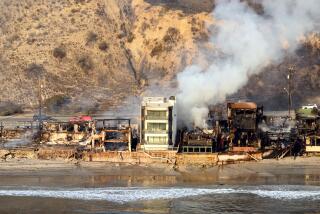Fire Report Says Homes Were Left Unguarded : Glendale: The decision to sacrifice a canyon may have cost 20 houses but helped save 700 elsewhere, Fire Department analysts conclude.
- Share via
Glendale firefighters deliberately left a neighborhood unprotected for two hours to halt the advance on another front of a fast-moving brush fire that damaged or destroyed 64 houses last June, including more than 20 in the unprotected canyon neighborhood, according to a long-awaited report by the city Fire Department released Tuesday.
The report, the only official analysis to be conducted of the devasting blaze, acknowledges that the department’s communications system was overtaxed and that firefighting resources were “stretched to a critical level” because three other Southern California fires also broke out that day--June 27.
But despite loud complaints from residents about the way the firefighting was conducted, Glendale Fire Chief John M. Montenero defended the strategy, calling it “the best possible approach.”
The fire, described as Glendale’s worst, erupted about 3:24 p.m. in the 1100 block of Verdugo Road, apparently after an arsonist tossed an incendiary device into the bone-dry hillside area. Driven by strong winds, the fire was contained in 3 1/2 hours after cutting a “serpentine” path through three neighborhoods, the report said.
The two-volume document, compiled by Fire Department personnel, analyzed the firefighting tactics and made recommendations aimed at reducing the risk of future hillside blazes. It answered some questions raised by angry fire victims, but left others unanswered.
In July, the Glendale Homeowners Coordinating Council, fearing the Fire Department’s report would not be impartial, asked the state fire marshal and the state attorney general to conduct an independent probe. But the state officials refused, saying the matter was outside their jurisdiction. So the report stands as the only official post-mortem.
Residents of Glenmore Canyon, where more than 20 houses were damaged or destroyed, have been particularly critical, charging that their neighborhood was left to burn while fire crews converged on other areas. The report conceded that the neighborhood was neglected because firefighters concentrated their efforts just ahead of the fire’s eastern edge to keep it from burning into Pasadena, saving more than 700 houses.
But because of this strategy, the report said, “areas including Glenmore Canyon were devoid of firefighting resources for approximately two hours into the incident.”
Barbara Leimeter, who lost her Glenmore Canyon home, said Tuesday she was not satisfied with this explanation.
“I can understand their decision in wanting to save those other houses,” she said. “But I don’t understand their decision to write us off before the fire had even crossed the Glendale Freeway. I’m paying taxes to be protected.”
At a Tuesday afternoon news conference on the report, City Manager David Ramsay, defended the department’s strategy in Glenmore Canyon.
“It’s like a war out there and they simply had to make some very tough judgment calls,” said Ramsay. “They had to make a decision on stopping this fire. They had to get ahead of it. They did that.”
“The combination of hot, dry weather; wood roofs; structures built close to the edge of the hill; and a wind . . . with gusts up to 25 knots, (created) a fire of such major proportion that it quickly overwhelmed the resources of the entire Glendale Fire Department . . .,” “ the report said.
The mutual aid system, in which neighboring agencies send firefighters, was stretched critically thin because of demands for help with the Santa Barbara, Carbon Canyon and Altadena fires, the report said.
The report also said fire damage was much less than the original estimate of $50 million. The revised figures were $15 million in insured losses and $4 million in uninsured losses. Sixty-four houses were damaged or destroyed, not 66, as originally reported.
To reduce losses in future fires, the report recommends that top fire officials receive more training in working with other agencies. It also states that the Verdugo communications system is undergoing a review aimed in part at preventing the “system overload” that occurred during the June 27 fire.
Fire officials discussed the report Tuesday night at a community meeting that drew about 40 people, including homeowner association leaders and fire victims. Some residents who used hoses to protect their homes complained that police officers forced them to leave even though there were no firefighters in sight.
Other residents suggested that the city purchase a water-dropping helicopter, because it took an hour for aircraft from neighboring departments to arrive. Still others suggested the city train volunteers to supplement its professional firefighters.
Montenero said he would look into the suggestions and complaints.
More to Read
Sign up for Essential California
The most important California stories and recommendations in your inbox every morning.
You may occasionally receive promotional content from the Los Angeles Times.













